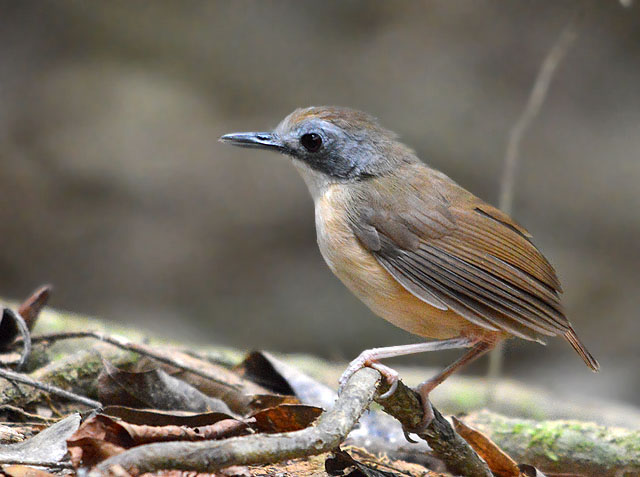After an incredible trip to Taman Negara, it will take something out
of the ordinary to get my adrenalin pumping again. Together with Hor Kee, we
set out to the forest that surrounds the mighty Sedim River in Kedah state.
This recreational forest is probably the best forest birding site close to home
and if there is anywhere that has what it takes to get me excited again, this would
be it. Reason being this is one of the few places that I frequent which still
has hornbills flying free in the skies above and broadbills deafening the forest
with their persistent vocals.
Babblers are certainly well represented in this locality. This family
of birds is the main reason why birders have such a colourful vocabulary of
swears and curses. Babblers tend to frequent dense vegetation, strongly believe
that death will bestow them if they stay still and get a kick out of frustrating
their human observers. The one thing that betrays their presence is their call.
Most birders have had plenty of practice at recognizing babbler calls because
you hear them more often you see them. The Scaly-crowned Babbler is a tree
babbler and that makes it a little easier to spot. A pair was rather confiding this
time round but the dim lighting and constant movement (what did I just tell
you?) proved to be too much for an ordinary mortal like me to obtain any better
shots.
This species does have a pleasant whistle and it echoed through the
vicinity during the encounter. The scaly crown is not a very prominent feature
and caution has to be taken to distinguish it from the similar Rufous-crowned
Babbler which we did hear calling later in the morning.
An inquisitive young male Green Broadbill swooped in to have a
better look at a couple of birders that were combing through his territory
looking for forest denizens like himself. A regularly encountered species here,
the Green Broadbill is a mesmerizing bird that can get me all excited even when
it is perched almost directly overhead and with the light coming from behind.
Having a good sense of hearing is very advantageous when birding in
the forest. No doubt many forest species have amazing plumage colourations and
yet they can still easily blend into the vegetation and shadows. Forest
kingfishers possess a certain aura of mystery and intrigue that their open
country relatives lack. The Dwarf Kingfishers may be adorable and all that but
it is the bigger species that truly tickle my fancy. I have been encountering
Rufous-collared Kingfishers here since my first visit more than a decade ago.
Their mournful whistle is very much a part of the natural chorus that greets
every visitor who enters this domain. However, I have come to a stage in my
life that I have almost given all hope of photographing this kingfisher. I left
Hor Kee to try and locate the kingfisher by himself while I scouted around for
other species.
My companion apparently does not share my fate when it comes to this
beautiful kingfisher and triumphantly signalled me over. It was a handsome bird
and he was not too far from the forest edge either. I cautiously crept closer. When
I was within shooting range, sweat started running down from my bare crown,
stung my eyes and tried to cloud my vision. But I was a man on a mission. No amount
of sweat and leeches will get in my way. I was in an awkward standing position
thanks to dense undergrowth and my arms strained as I stabilized my camera for
the moment of truth. Lighting was not on my side and a twig slightly blocked my
subject but I took the shots. I had a gut feeling if I took one more to the
right for an unobstructed view, my subject will inevitably fly and disappear
from sight. At times I give in too easily to my desire for better shots. I am
not proud of it but I took that step. From the single shot of the kingfisher
posted, you can pretty much guess the outcome.
Trogons are another good reason to explore the forest here. A male
Diard’s Trogon taunted us from the cover of the canopy level and despite all
our efforts, managed to elude our cameras. Our persistent almost paid off when
a trogon suddenly alighted on an exposed branch but much to our bewilderment,
it was a male Orange-breasted Trogon. The male Diard’s Trogon went on with his
vocal performance at the same and that answered a lot of questions regarding
our sanity and birding abilities - much to my relief. Anyway, the male
Orange-breasted Trogon may not be as visually stunning as the male Diard’s
Trogon and the perch was not exactly within my photographic gear’s comfort zone
but he provided a good ending to our excursion. Sungai Sedim may not be in the
same league as Taman Negara but it is still a birding hotspot in its own right.
And it is close to home.




















































